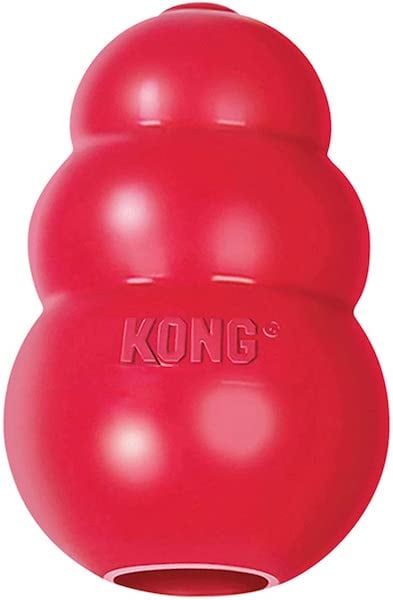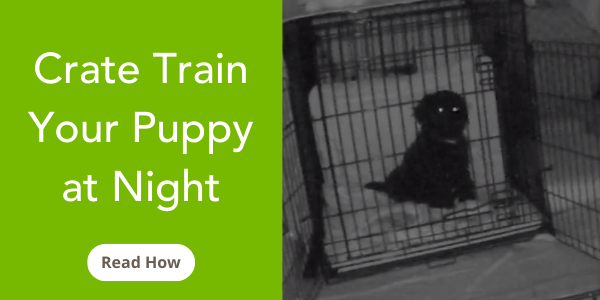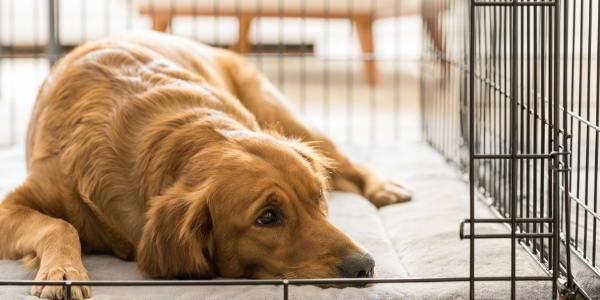
Wondering about the best way to crate train your puppy or adult dog? Or if you should even bother?
Perhaps you’re worried that it might be cruel to confine your dog to a crate? (It’s
If you’re at all curious about crate training a dog, regardless of their age, you’ve come to the right place. This article will answer all your questions and walk you through a stress-free process of crate training.
How to Crate Train Your Puppy or Dog
Nighttime Crate Training
How Long Can You Crate a Dog?
How Long Does Crate Training Take?
Crate Training Multiple Dogs
Are Dogs Den Animals?
Benefits of Crate Training
Crate Selection & Set-Up
How to Crate Train Your Puppy or Adult Dog
Here’s a step-by-step guide to crate training a puppy or adult dog. Keep your crate training sessions short and sweet when you're first introducing your pup to their crate. By moving at your dog's pace you're setting them up for success and helping to prevent any anxiety about being confined in a crate.
Step 1: Create a Positive Association With the Crate
The ultimate goal is for your dog to view their crate as a wonderful place to hang out. You can do this by pairing your dog's choice of going into the crate and settling in the crate with great things happening to them.
- Place cozy blankets and favorite toys inside the crate with the door wide open and allow your puppy to explore it on their own. If they don’t enter the crate, toss in a few treats to encourage further exploration.
- Any time you catch your dog going into their crate, immediately click with a clicker (or use your marker word) to let them know that’s the behavior you want. Then toss a treat to them in the crate. This is called "capturing" a behavior.
(Not sure how to clicker train? Check out our “Introduction to Clicker Training” article.) - Feed your puppy their meals in the crate. If your puppy or dog is still nervous about entering the crate, you can place their food bowl outside of the open crate to help them get more comfortable over time. Slowly begin moving the food bowl closer to the crate each meal, and eventually into the crate, as they are comfortable.
- As your pup becomes comfortable eating inside the crate, you can close the door to the crate during feeding. Be sure to open the door as soon as your pup is finished.
Here's an example of my puppy Fozzie Bear during one of his first crate meals to begin to build this positive association:
Step 2: Put it on Cue!
A big step forward in creating positive associations with the crate is to play training games. These games turn into being able to cue your dog to "go to crate!" and they'll happily run in all by themselves. You have a couple of options when it comes to different techniques to teach your dog to go to crate: luring and shaping.
The luring technique is often the easiest to start with, but shaping often results in faster learning. I suggest starting with luring and then switching quickly to shaping once your pup gets the hang of it.
Let's quickly go over how to do both of these techniques.
Luring Your Dog into Their Crate
- Hold a treat in one hand and use it as a target for your dog to follow. You can start by holding it right in front of their nose and guiding them into the crate. Or you can hold the treat through the side or back bars of the crate to entice your dog to step into the crate.
- Once they step into the crate, say "yes!" and give them the treat.
- Repeat!
The luring movement of your hand with the treat will eventually become your dog's hand signal to go to their crate. Most often, this tends to be a simple point with the hand and fingers.
- As your dog is starting to follow the lure faster each time you do it, you can remove the treat from that luring hand. This is where the lure becomes a "prompt" or hand signal.
- If they follow the hand signal, say "yes!" when they hop in the crate, praise and treat!
Once your dog is consistently responding to the hand signal (without a treat in that luring hand), then it's time to add in the verbal cue, which we'll cover below.
Shaping Your Dog to Go into Their Crate
This training method is by far my favorite! Shaping is marking and rewarding small approximations — "slices"— of the full behavior. For going into the crate, these approximations are: look at the crate, one foot in the crate, two feet in, all feet in, lay down in the crate, stay in the crate, and so on. Shaping really puts your dog's brain to work and works their puzzle-solving skills!
- Grab your treat pouch that's stocked with lots of yummy training treats and your clicker. If you're not clicker training, a marker word like "yes!" works as well.
- Stand or sit near the crate.
- Click or say "yes!" the instant your dog looks at the crate or moves towards it.
- Toss the treat away from the crate. This resets them for the next repetition.
- Repeat this step before moving on to the next approximation.
You'll see a lightbulb moment happen for your dog during the early stages of shaping. Once they figure out what gets them a click or marker word (and then the treat), they will start offering that behavior faster each time. When you see that lightbulb moment, you can add in the next approximation.
- When your dog looks at the crate, don't click right away. Wait to see if they offer movements towards or even a paw into the crate.
- If they take a step in, click and treat!
- You can give the treat inside the crate to encourage staying in the crate (check out the video below to see me do this).
- If they get frustrated, you can go back a step in training or you can toss a treat into the crate as a lure (think of it as a hint). But if you do this, make sure to click when they hop in the crate and then toss a treat outside of the crate to reset them.
- Repeat!
- Add in more approximations of the full "go to crate" behavior.
Here's a video of my puppy Fozzie Bear, working through the go to crate cue. You'll notice I use the luring method for the first repetition to jump-start the session before moving into shaping.
Adding a Verbal Cue for "Go to Crate"
When your dog is happily hopping into their crate with either the hand signal or anticipating that's what you want using the shaping method, it's time to add the verbal cue. It's easy to do!
- As your dog is getting into the crate, simply say "crate!" (or whatever you'd like your dog's cue to be).
- Click/"yes!" as normal and treat.
- Repeat!
This is just teaching your dog that the sound you make means to perform that behavior. Repetition is key here, as well as consistency on your part. Don't change your verbal cue halfway through, and try not to repeat the verbal cue (this tends to be the hardest part for us humans).
Step 3: Work on Duration
While it may not happen the first time, the goal is to be able to leave your puppy in a closed crate for 15 minutes without stress. You can build up to this longer duration a few different ways. Combine the two techniques below for the fastest crate training process.
Long-Lasting Stuffed Food Puzzles and Toys
Use a stuffed Toppl or Kong toy as the reward for getting into and staying in the crate. Place the toy in the crate with them and then shut the door briefly. Aim for just 10-15 seconds or so to start. Then open the door, trade them for the toy using a few treats outside of the crate, and remove the stuffed toy.
Hang out near the crate doing nothing for about 10 seconds, and then repeat! Add on more time in the crate with the door closed as they progress.
My favorite stuffable toys for crate practice are the Kong and the West Paw Toppl. The Kong is a classic (it's literally in the name) but heads up that it can take some practice for dogs, and especially puppies, to learn how to "de-stuff" a Kong. If they aren't successful, the small opening can cause frustration and they then lose interest in stuffed toys.
I usually begin with the Toppl, which has a larger opening and is easier to get all the yummy stuff out before increasing the difficulty level with a Kong. (Bonus: the Toppl is also easier for us humans to stuff and then clean after each use, and both are dishwasher safe!)
Here are some additional tips to keep in mind for this method:
- Progress slowly and do not leave your dog’s side.
- You’ll know you’re doing it right if your dog stays happily engaged with their toy or food puzzle, rather than whimpering or acting anxious.
- If your puppy struggles to meet the goals, try increasing the value of their toy or food puzzle (fill it with their favorite treats!) and/or make the time shorter.
- Throw in easy durations between the longer durations (i.e., 30 seconds, 45 seconds, 20 seconds, one minute, etc.).
- To make the first step easier and less scary for your puppy, close the crate door most of the way, but keep your hand inside. Hold onto their toy or food puzzle while they play with it, and praise and talk to them in a comforting voice. Do this until your puppy is comfortable playing even when your hand is out of the crate.
Shaping Duration in the Crate
Similar to how you shaped getting into the crate, you can shape adding duration and staying in the crate. Don't worry about clicking for a longer time in the crate, focus instead on intermittently dropping a treat in the crate as you slowly increase the duration. Here's a video showing Fozzie Bear practicing duration:
Notice how I give him a treat inside the crate after I open the door? I love how he doesn't just rush out of the crate the instant the door opens, so I want to reward that nice stay behavior!
Step 4: Increase Your Distance From the Crate
Repeat Step 3, except increase distance instead of duration. Close the crate door with your puppy inside, walk halfway across the room, return, open the crate and make a trade for the puzzle toy (or drop a treat in the crate). Repeat this until you are able to walk out of sight and return without your dog feeling stressed.
Check out Fozzie Bear in this video where I introduce adding distance. You'll notice that I start with just leaving some yummy chews in the crate, but since he wasn't interested in them during this session, I switched to scattering treats in the crate instead.
Step 5: Distance + Duration
Add duration to the distance. Start with increments of 15–30 seconds while you walk around the house in and out of
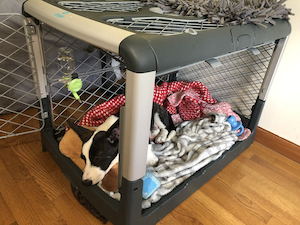 Step 6 and Beyond: Distraction and Real Life
Step 6 and Beyond: Distraction and Real Life
Once your dog is comfortable being left in the crate for 15 minutes with their toy or food puzzle, you can start adding additional elements to the training:
- Leave the crate open and easily accessible for your dog to choose to go in and settle on their own when not training. Fozzie Bear, as seen in the inset photo, loved napping in his crate and didn't rely on my cueing him to go there throughout the day. Positive association for the win!
- Leave your puppy in the closed crate for longer amounts of time to build longer durations.
- If using a food puzzle, delay your return once they’ve eaten all the stuff inside. You should always leave a safe toy or entertaining food puzzle in the crate with your dog, but you also want them to be okay when the entertainment that a toy or food puzzle provides runs out. If your puppy has been exercised and did well with the first five steps, this should be a natural and easy progression.
- Don’t make a big production out of your departure from the home. Have your dog “kennel up” and start working on their food puzzle or toy several minutes before your departure. Then just leave the house without fanfare while they’re happily playing with their toy/food puzzle. This can help reduce the chances of separation anxiety developing.
- Apply crating to all of the necessary real-life scenarios, such as when you sleep, eat dinner, have visiting guests, ride in the car, etc. If your puppy vocalizes a little because they are excited or want to be let out, wait until they are quiet for a few seconds before letting them out.
That said, when first starting out with crate training (especially when working on Step 1, developing positive associations with the crate) you don’t want to let your pup “cry it out.” If they’re really not having fun, just let them out and start over at the duration/distance at which they were last comfortable and then work up more slowly.
Crate Training at Night
Crating your puppy at night is often the best choice when it comes to sleeping arrangements. Doing so benefits their potty training and helps build a solid sleeping schedule and routine. Not to mention that it keeps them safe and out of trouble if they decide they want to explore and chew on things while you're asleep.
As your puppy matures and after they are completely house trained, then you can think about whether having them sleep in the bed with you or on their own bed on the floor works best for your preferences and lifestyle.
There are a few differences between daytime crate training and nighttime crate training, and I dive deeper into nighttime crating in our article "Crate Training Your Puppy at Night." Check it out to learn what to do if your puppy is whining or barking and how to help them settle.
Your Dog's Crate is Not for Punishment
Don’t use the crate for punishment or reprimand your dog while they’re in their crate. Otherwise, your dog will come to associate their crate with stress and other negative experiences, making crate training efforts much harder for you both.
With that being said, the crate does play an important role in behavior management and setting your dog up for success. Especially when it comes to problem behaviors such as jumping on people or puppy nipping. If your puppy is overstimulated and having trouble with excessive nipping or jumping, there is nothing wrong with giving them a brief "downtime" in their crate or pen.
Give them something positive and fun to do in their crate, such as a stuffed food toy or safe chew. This builds that positive association with the crate AND prevents them from practicing unwanted behaviors. Win-win!
How Long Can I Leave My Puppy in Their Crate?
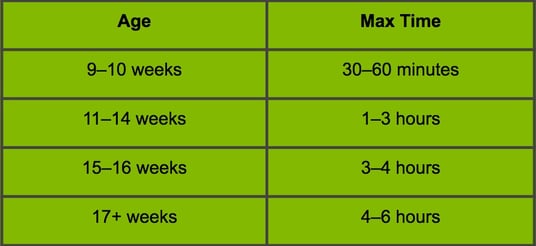
Use this chart as an age-based guide for how long your pup can “hold it” and stay in their crate.
Note that these are consecutive minutes/hours, not total time during the day or night.
Young puppies shouldn't be expected to handle crate confinement for long periods of time during the day. Their little bladders make this difficult and they need time to develop positive associations with their crate space. If you are unable to give your puppy a break from their crate within the times listed above, set up a Puppy Zone or Long-Term Confinement Area instead of a crate.
And remember, each dog is unique. Some may need more practice before being able to stay in their crate for these lengths of time, while others might love their crate right away!
No matter their age, don’t leave your dog in the crate all day. Crates are no substitute for a dog sitter. A dog that is locked in a crate all day and night may develop anxiety and depression. If your work or other schedule conflicts will keep you away from home for a long chunk of the day, consider hiring a pet sitter or dog walker, or taking your dog to daycare so they can get the physical and mental exercise they need each day.
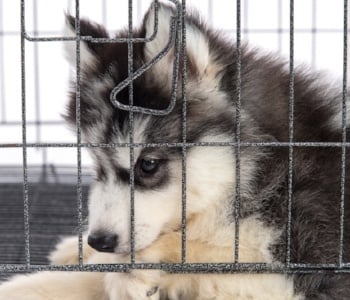
How Long Does Crate Training Take?
As with any type of training, all dogs will learn and progress through their crate training at a different pace. The keys to success are consistency and patience (and lots of positive reinforcement!). Stick with consistent positive training and you’ll soon have a dog that LOVES their crate … and you’ll have a safer home and less stress in your life, as well.
If a puppy was introduced to crates early in their life (such as with their breeder or in their foster home), I usually anticipate successful crate training within one to three weeks of starting consistent crate training practice. If crates are brand new to them, it may take longer.
However, if a puppy or adult dog has previous negative experiences in a crate environment, it can take much longer to undo this damage and help them view that space as a positive place to be. In these cases, I recommend beginning with a larger confinement area, such as a playpen as described in "Puppy Zone: How to Set Up a Long-Term Confinement Area."
Crate Training When You Have Multiple Dogs
You may have already shared your life with a dog prior to bringing home a new dog. If you're planning on crate training your new furry bundle of joy, you may be wondering how to go about one dog being crated while the other is roaming free.
Young puppies and even adolescent dogs often need to be confined to keep them safe from household dangers or prevent them from destructive chewing, but older dogs have earned more freedom with age and maturity.
Here are a couple of options:
- If your established dog has been crate trained, consider having them spend some time in their crate at the same time your new dog does. This can help prevent FOMO ("fear of missing out") in your new pup if they see the other wandering around and they want to join in the fun.
- If your other dog is not crate trained, start a crate training plan with them following the same steps above! A dog is never too old to learn.
- If your other dog is pretty mellow and won't be intentionally bugging your new dog while they are resting in the crate, you can let them wander as usual. However, to be on the safe side, consider crating your new dog in a separate room or gated-off area to lessen the chance that they'll be disturbed.
Should You Crate Two Dogs Together?
The short answer to this question is no. Dogs need their own space and being confined in a smaller area with another dog can be a recipe for disaster. If one gets a little testy (or perhaps they begin resource guarding a yummy stuffed toy), they could end up in a fight in close quarters. Not only can this result in serious injuries, but it also makes the crate space a very negative and stressful place for your dogs.
But you may be wondering, what about littermates? If you've brought home two littermates, it's especially important to crate them separately. Raising two littermates is quite the task, as often they will bond intensely with each other and less so with their human family members. This can lead to quite a few behavioral issues later on that are difficult to address. Crating littermates separately gives them a chance to learn how to be away from each other and gives them crucial decompression time and personal space.
Are Dogs Den Animals?
First, let’s start with clearing up some potential confusion and putting your mind at ease. You may have seen conflicting articles or received differing opinions on whether dogs are “den animals” (animals that live the majority of their lives underground or in a cave).
The truth is that while dogs aren’t technically “den animals,” as they certainly don’t spend the majority of their lives in a den, they do have a denning instinct. Pregnant dogs seek out the safety of a den to birth and rear their pups.
So some of your puppy’s earliest memories tie back to the comfort and safety of being with mom (and littermates) in a safe, secure, den-like space. Additionally, when dogs are ill, injured, or otherwise needing a place to relax and feel safe, they will seek out a den or “den-like” protected space.
While you may worry that your dog will see their crate as a “jail cell,” the truth is actually quite the opposite. When crate training and conditioning is done correctly, a crate provides a calming and protective space where your dog can relax and feel secure — and truly be safe.
Benefits of Crate Training Your New Puppy or Dog
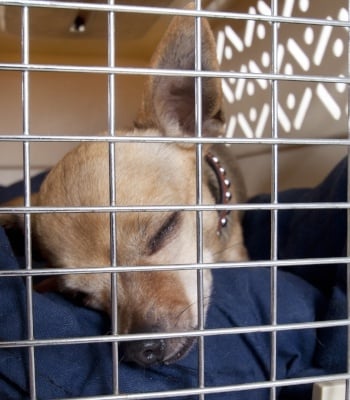
Crates benefit both ends of the leash: your dog and you. They aren’t just relaxing and protective for your pup, they also provide you with peace of mind and precious moments of relaxation! Here are some of the reasons why crate training is important:
- Help with house training: A crate is a great tool to help house train a puppy.
- Noise refuge: The crate provides a safe space for your dog to relax, as well as a place to retreat during anxiety-inducing times like holidays, parties, thunderstorms, rampaging kids, and a host of other potentially stressful events that happen in our homes on a regular basis.
- Easy transport: Crates make it easier to safely transport your dog in the car.
- Injury and toxicity prevention: A crate can help prevent injuries and poisonings for dogs when
they are home alone while you run errands or go to work. - Protect your stuff: Crate training helps protect your furniture, floors, and the rest of your home while you’re out.
- Home away from home: A dog that’s properly crate conditioned will be more comfortable and relaxed when they need to be
crated at the vet, groomer, or a boarding kennel. - Post-surgery convalescence: They’ll also be happier, safer, and less likely to have a
surgical failure or other complications following any surgeries that require post-operative exercise restriction (e.g., spay, fracture repair, cruciate surgery).
More Crate Training Resources
We've covered lots of information above when it comes to the process of crate training. But you might be wondering what size of crate your dog needs and what's safe to leave in the crate with them. We've got you covered! Check out these related articles with tips and how-to's when it comes to creating the most zen crate space for your pup.
- Setting Up Your Dog's Crate for Comfort & Safety
- How to Measure and Choose a Crate for Your Dog
- Crate Training a Puppy at Night
- Tips for Helping Your Puppy Sleep Through the Night
And if your dog is struggling with crate training, you're not alone! I've created a virtual course just for this issue. Get in-depth crate training help in our Puppy Essentials Crate Training Workshop. You'll get unlimited access to self-paced training modules, video demonstrations, training tips, and more — all for only $9.






